ART NEWS: Jan.01
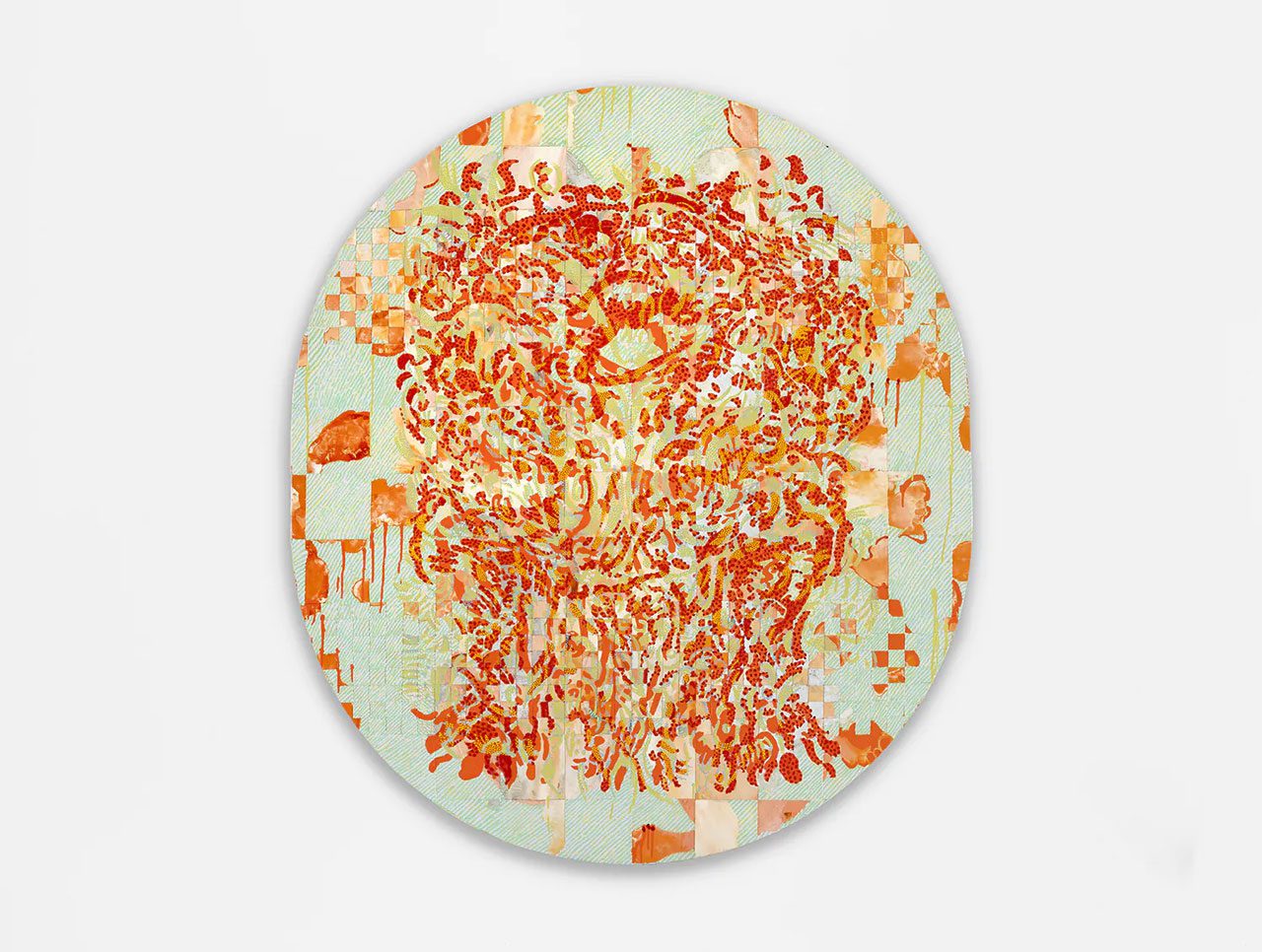 François Rouan presents “Recorda” his first solo exhibition in New York the exhibition features a selection of paintings and photographs drawn from both earlier and recent series, alongside a loan from the Pierre and Tana Matisse Foundation. The exhibition features thirty pieces, wax paintings and photographic work in various formats – square, rectangular and oval – all created between 1969 and 2024. “Recorda” interweaves the artist’s brand new eponymous series, created in 2023-2024, with older pieces from the late 1960s, 1980s and 1990s. Together they bear witness, once again, to the artist’s insatiable passion for working with the surface. Rouan begins by focusing on strips of canvas dyed in a palette of explosive hues, from canary yellow and brick red to cobalt blue and coal black. He carefully braids them on the painting then plays with the result, boldly shredding, interlacing, reviewing, completing or even breaking up the surface and starting all over again. Behind the seeming simplicity of motifs and colour range lie some of the metaphysical questions that obsess the artist, such as the painting as a work of art, the world’s origins, body image, and human existence. Info: Curator: Alfred Pacquement, Galerie Templon, 293 Tenth Avenue, New York, NY, USA, Duration: 9/1-1/3/2025, Days & Hours: Tue-Sat 10:00-18:00, www.templon.com/
François Rouan presents “Recorda” his first solo exhibition in New York the exhibition features a selection of paintings and photographs drawn from both earlier and recent series, alongside a loan from the Pierre and Tana Matisse Foundation. The exhibition features thirty pieces, wax paintings and photographic work in various formats – square, rectangular and oval – all created between 1969 and 2024. “Recorda” interweaves the artist’s brand new eponymous series, created in 2023-2024, with older pieces from the late 1960s, 1980s and 1990s. Together they bear witness, once again, to the artist’s insatiable passion for working with the surface. Rouan begins by focusing on strips of canvas dyed in a palette of explosive hues, from canary yellow and brick red to cobalt blue and coal black. He carefully braids them on the painting then plays with the result, boldly shredding, interlacing, reviewing, completing or even breaking up the surface and starting all over again. Behind the seeming simplicity of motifs and colour range lie some of the metaphysical questions that obsess the artist, such as the painting as a work of art, the world’s origins, body image, and human existence. Info: Curator: Alfred Pacquement, Galerie Templon, 293 Tenth Avenue, New York, NY, USA, Duration: 9/1-1/3/2025, Days & Hours: Tue-Sat 10:00-18:00, www.templon.com/
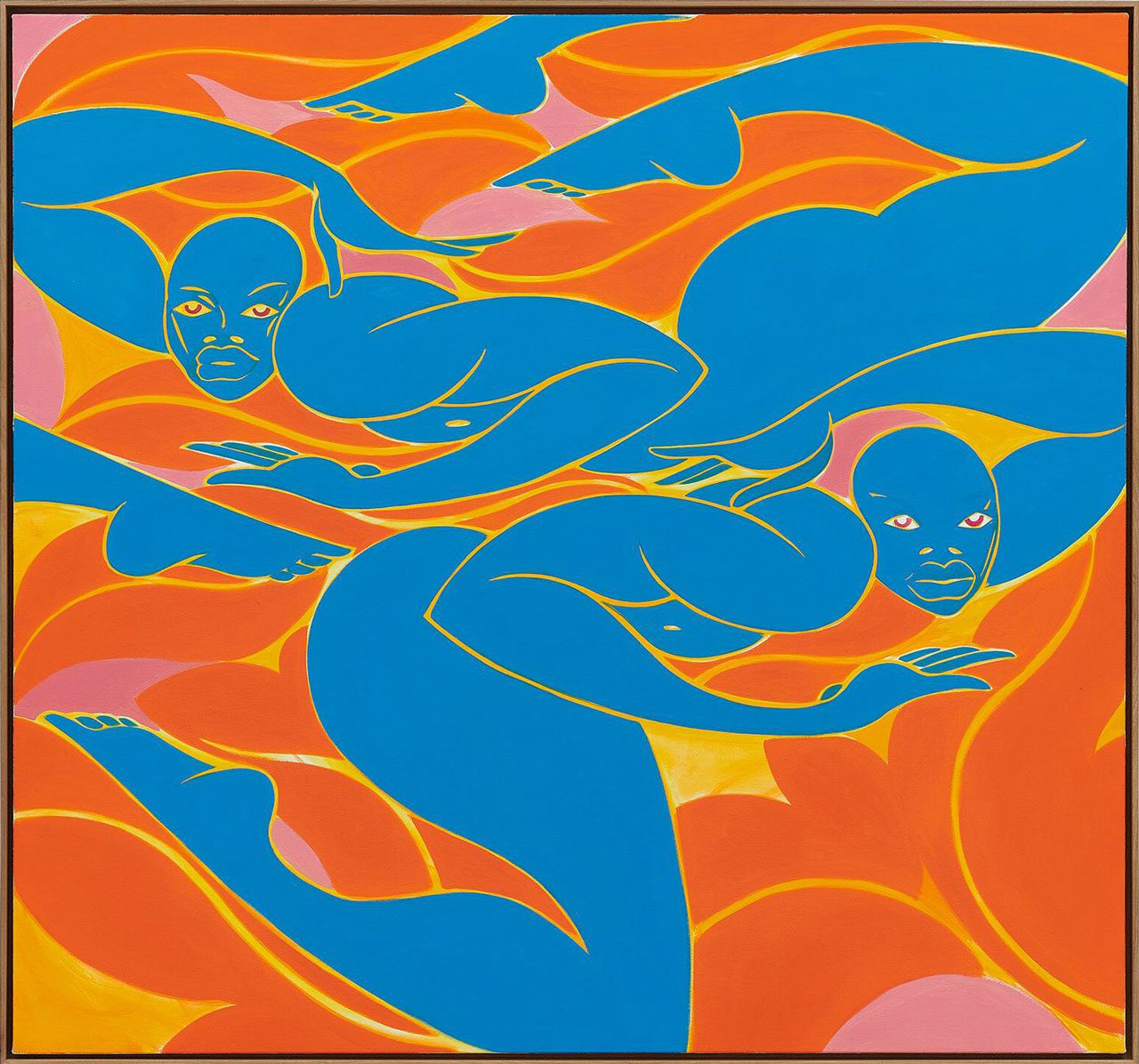 Tunji Adeniyi-Jones presents “Immersions”, his first solo exhibition in Korea. Tunji Adeniyi-Jones’s paintings emerge from a perspective of what the artist describes as ‘cultural addition, combination and collaboration’. Born and educated in the UK and now living and working in the USA, his practice is inspired by the ancient history of West Africa and its attendant mythology, and by his Yoruba heritage. Often beginning with studies in ink pen or watercolor on paper as a means to explore his imagery, he employs a varied palette and works with different seasons or times of day. His boldly colored paintings are set within a flat, shallow space located in modernist abtraction as well as the narratives and symbolism of West Africa. In these, abstract backgrounds of lush, stylized foliage proliferate across the canvas surface, the sinewy bodies emerging and dispersing into the tessellating shapes and interlocking swathes of color. The figures are rendered in a vibrant single color and built up from a composite of neatly connecting organic forms, and appear tightly contained within the confine of the picture plane. Reds, oranges and yellows or vivid combinations of scarlet and fuchsia blend together in compositions that reference the Dutch wax-resist fabric designs common to Africa, themselves a product of complex cross-cultural exchange. In some works a predominantly dark palette using a tonal range of indigo and violet, conjures night time, with figures outlined in pale colours that give them an otherworldly appearance, of luminous spirits from a vision or dream. Info: White Cube Gallery, 6, Dosan-daero 45-gil, Seoul, South Korea, Duration: 110/1-22/2/2025, Days & Hours: Tue & Fri-Sat 10:00-18:00, Thu 16:00-19:00, www.whitecube.com/
Tunji Adeniyi-Jones presents “Immersions”, his first solo exhibition in Korea. Tunji Adeniyi-Jones’s paintings emerge from a perspective of what the artist describes as ‘cultural addition, combination and collaboration’. Born and educated in the UK and now living and working in the USA, his practice is inspired by the ancient history of West Africa and its attendant mythology, and by his Yoruba heritage. Often beginning with studies in ink pen or watercolor on paper as a means to explore his imagery, he employs a varied palette and works with different seasons or times of day. His boldly colored paintings are set within a flat, shallow space located in modernist abtraction as well as the narratives and symbolism of West Africa. In these, abstract backgrounds of lush, stylized foliage proliferate across the canvas surface, the sinewy bodies emerging and dispersing into the tessellating shapes and interlocking swathes of color. The figures are rendered in a vibrant single color and built up from a composite of neatly connecting organic forms, and appear tightly contained within the confine of the picture plane. Reds, oranges and yellows or vivid combinations of scarlet and fuchsia blend together in compositions that reference the Dutch wax-resist fabric designs common to Africa, themselves a product of complex cross-cultural exchange. In some works a predominantly dark palette using a tonal range of indigo and violet, conjures night time, with figures outlined in pale colours that give them an otherworldly appearance, of luminous spirits from a vision or dream. Info: White Cube Gallery, 6, Dosan-daero 45-gil, Seoul, South Korea, Duration: 110/1-22/2/2025, Days & Hours: Tue & Fri-Sat 10:00-18:00, Thu 16:00-19:00, www.whitecube.com/
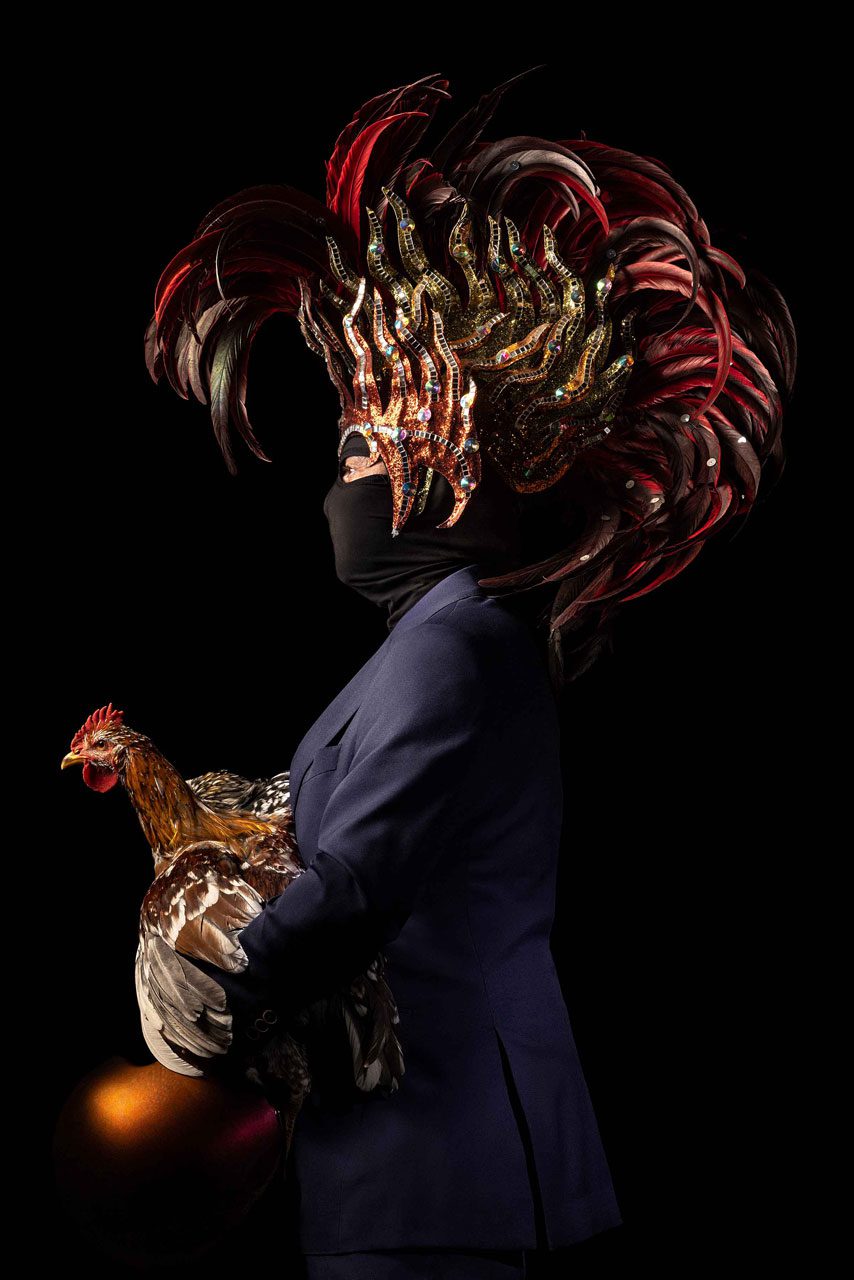 Sandra Knecht has been exploring the concept of “home” for over a decade. For Knecht, home is a fluid concept, constantly renegotiated, both individual and ephemeral. Her art delves into what home, as an unknown place, means in geographic, historical, sociological, philosophical, and culinary terms. The exhibition “Home Is a Foreign Place” addresses the concept of home in various ways – as a feeling, a place, and an idea. It questions how our understanding of home evolves and how deeply it impacts human existence. This exhibition is the result of ten years of intense research and artistic work, in which Knecht has consistently pursued her examination of themes like home, identity, and diversity. “Home Is a Foreign Place” represents the concentrated culmination of Sandra Knecht’s practice and is her most extensive solo exhibition to date. Sandra Knecht’s personal path to art, like her work, is unconventional. In 2011, she began studying visual art after spending over two decades working as a social worker. Her profession often brought her into the kitchens of the families she worked with, where they cooked together, exchanging culinary traditions and building bridges. These experiences continue to nourish her artistic practice. Knecht’s research is always long-term and materializes itself in various formats: installation, archive, photography, poetry, video, sound, performance, sculpture, and culinary art. Info: Kulturstiftung Basel H. Geiger | KBH.G, Spitalstrasse 18, Basel, Switzerland, Duration: 10/1-27/4/2025, Days & Hours: Mon & Wed-Sun 11:00-18:00, www.kbhg.ch/
Sandra Knecht has been exploring the concept of “home” for over a decade. For Knecht, home is a fluid concept, constantly renegotiated, both individual and ephemeral. Her art delves into what home, as an unknown place, means in geographic, historical, sociological, philosophical, and culinary terms. The exhibition “Home Is a Foreign Place” addresses the concept of home in various ways – as a feeling, a place, and an idea. It questions how our understanding of home evolves and how deeply it impacts human existence. This exhibition is the result of ten years of intense research and artistic work, in which Knecht has consistently pursued her examination of themes like home, identity, and diversity. “Home Is a Foreign Place” represents the concentrated culmination of Sandra Knecht’s practice and is her most extensive solo exhibition to date. Sandra Knecht’s personal path to art, like her work, is unconventional. In 2011, she began studying visual art after spending over two decades working as a social worker. Her profession often brought her into the kitchens of the families she worked with, where they cooked together, exchanging culinary traditions and building bridges. These experiences continue to nourish her artistic practice. Knecht’s research is always long-term and materializes itself in various formats: installation, archive, photography, poetry, video, sound, performance, sculpture, and culinary art. Info: Kulturstiftung Basel H. Geiger | KBH.G, Spitalstrasse 18, Basel, Switzerland, Duration: 10/1-27/4/2025, Days & Hours: Mon & Wed-Sun 11:00-18:00, www.kbhg.ch/
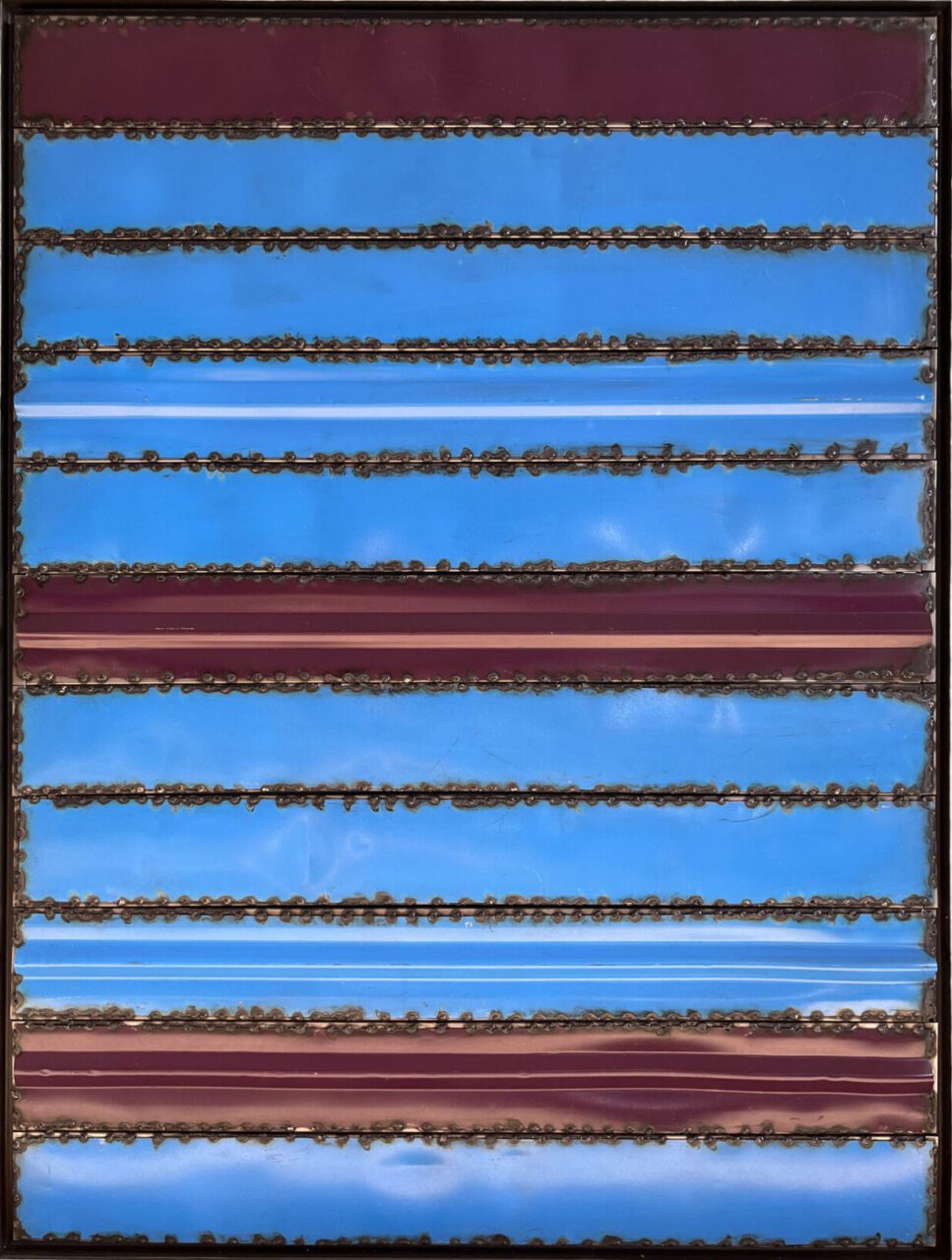 Kevin Rouillard’s solo exhibition “Lines: Echoes & Assemblage” brings together a newly created body of work. Kevin Rouillard explores here the horizon line well beyond its conventional definition presenting it as a visual limit, one where the distance between sky and earth has become so small that these two parts seem to merge together. By investing the gallery walls, the artist uses this line, both as an element of formal vocabulary, specific to each work, but also as a visual tool capable of redefining our perception of the architecture where the works are hung.The allusion to a distant landscape is signified by an overall geometry which includes a repetition of colored stripes creating a rhythmical order and visual resonances. Far from neglecting the aesthetic field of the abstract painting defined by Clement Greenberg, Rouillard offers here a universe where each metal work echoes the previous one and where the assembled colors create spaces for contemplation. As for the technique used, the welding of strips of metal, it reveals to the viewer that gesture and material are closely linked and that their combination can alter our perception and feeling of space. Info: Xippas Gallery, 108 rue Vieille-du-Temple, Paris, France, Duration: 11/1-1/3/2025, Days & Ηours: Tue-Fri 10:00-13:00 & 14:00-19:00, Sat:10:00-19:00, www.xippas.com/
Kevin Rouillard’s solo exhibition “Lines: Echoes & Assemblage” brings together a newly created body of work. Kevin Rouillard explores here the horizon line well beyond its conventional definition presenting it as a visual limit, one where the distance between sky and earth has become so small that these two parts seem to merge together. By investing the gallery walls, the artist uses this line, both as an element of formal vocabulary, specific to each work, but also as a visual tool capable of redefining our perception of the architecture where the works are hung.The allusion to a distant landscape is signified by an overall geometry which includes a repetition of colored stripes creating a rhythmical order and visual resonances. Far from neglecting the aesthetic field of the abstract painting defined by Clement Greenberg, Rouillard offers here a universe where each metal work echoes the previous one and where the assembled colors create spaces for contemplation. As for the technique used, the welding of strips of metal, it reveals to the viewer that gesture and material are closely linked and that their combination can alter our perception and feeling of space. Info: Xippas Gallery, 108 rue Vieille-du-Temple, Paris, France, Duration: 11/1-1/3/2025, Days & Ηours: Tue-Fri 10:00-13:00 & 14:00-19:00, Sat:10:00-19:00, www.xippas.com/
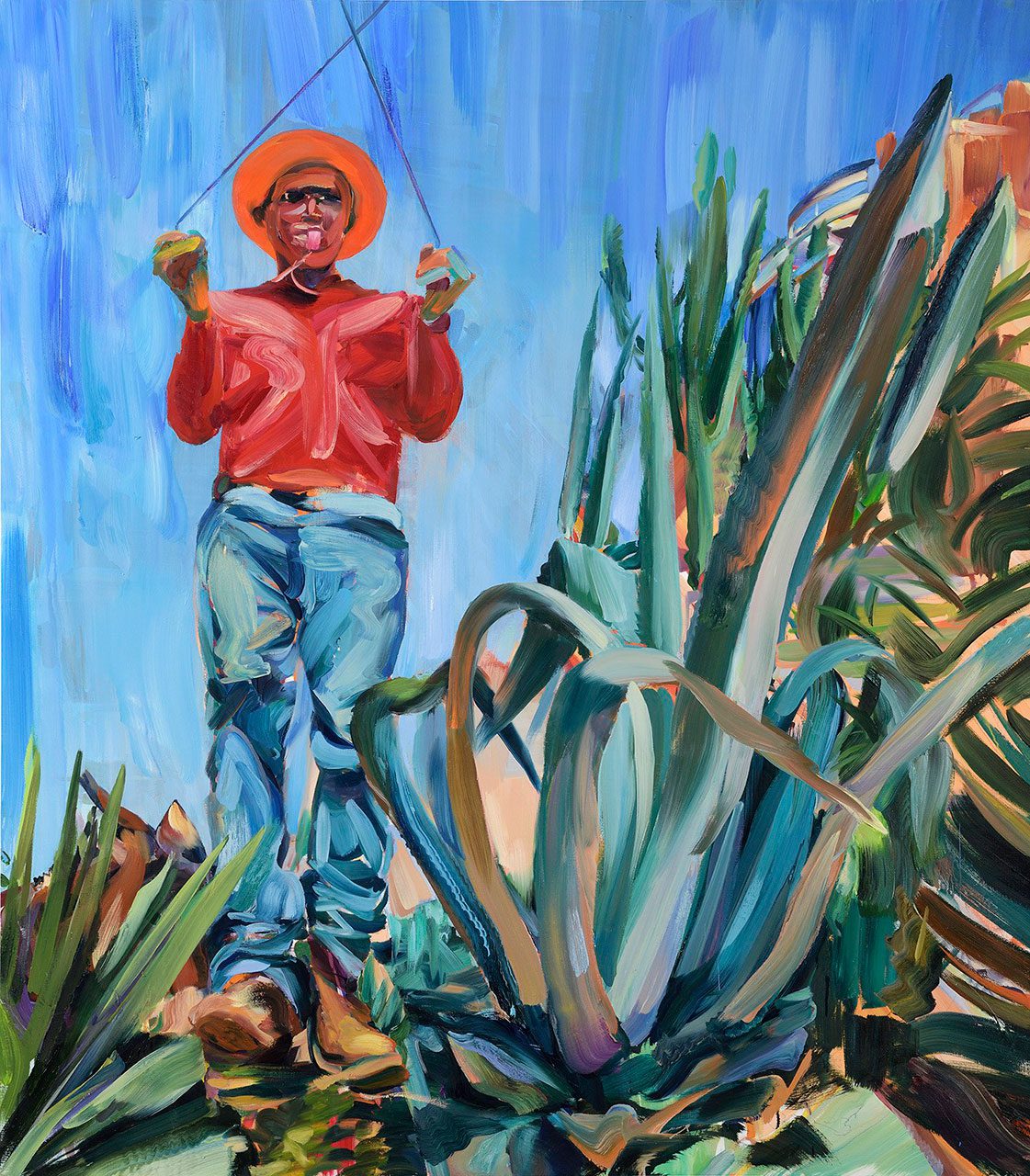 In choosing “Mhondoro ye Mvura”, as his exhibition title, artist Duncan Wylie has reappropriated the sounds of a language he has heard since birth, Shona, which he has set aside since moving to Europe in 1995. His African roots, deeply anchored in his memory, constantly inform his brushstrokes and his personal iconography. The exhibition embody the idea of a protective entity linked to water, a symbol of life and purification in Shona culture. Water is, of course, an eminently precious element which is sometimes scarce in Zimbabwe. Wylie celebrates it through a number of images, including those of the dowser, the well, the swimming pool, and also trees and their sources of life. The painter has a strong bond with this indispensable component. Many artists have risen to the challenge of its representation – so evanescent, furtive and difficult to transcribe. Beyond the difficulty involved in depicting this element, Wylie adds a political character to this series of previously unseen works, including an evocation of the relationship between Africa and the West. His wells, dowsers and water vendors are all metaphors for rich countries’ appropriation of African resources. It’s worth noting that the majority of the Zimbabwean population lives by selling goods on the streets. And even though this market is linked to the vital element of water, the police regularly intervene to shut it down, thereby polarising this essential issue in Zimbabwe. The opulence of villas with swimming pools in wealthy neighbourhoods has been made possible by the exploitation of local resources, including water. The current situation in Zimbabwe therefore continues to inform Wylie’s work in an allegorical way. Info: Backslash Gallery, 29 rue Notre-Dame de Nazareth, Paris, France, Duration: 11/1-15/2/2025, Days & Hours: Tue-Sat 14:00-19:00, www.backslashgallery.com/
In choosing “Mhondoro ye Mvura”, as his exhibition title, artist Duncan Wylie has reappropriated the sounds of a language he has heard since birth, Shona, which he has set aside since moving to Europe in 1995. His African roots, deeply anchored in his memory, constantly inform his brushstrokes and his personal iconography. The exhibition embody the idea of a protective entity linked to water, a symbol of life and purification in Shona culture. Water is, of course, an eminently precious element which is sometimes scarce in Zimbabwe. Wylie celebrates it through a number of images, including those of the dowser, the well, the swimming pool, and also trees and their sources of life. The painter has a strong bond with this indispensable component. Many artists have risen to the challenge of its representation – so evanescent, furtive and difficult to transcribe. Beyond the difficulty involved in depicting this element, Wylie adds a political character to this series of previously unseen works, including an evocation of the relationship between Africa and the West. His wells, dowsers and water vendors are all metaphors for rich countries’ appropriation of African resources. It’s worth noting that the majority of the Zimbabwean population lives by selling goods on the streets. And even though this market is linked to the vital element of water, the police regularly intervene to shut it down, thereby polarising this essential issue in Zimbabwe. The opulence of villas with swimming pools in wealthy neighbourhoods has been made possible by the exploitation of local resources, including water. The current situation in Zimbabwe therefore continues to inform Wylie’s work in an allegorical way. Info: Backslash Gallery, 29 rue Notre-Dame de Nazareth, Paris, France, Duration: 11/1-15/2/2025, Days & Hours: Tue-Sat 14:00-19:00, www.backslashgallery.com/
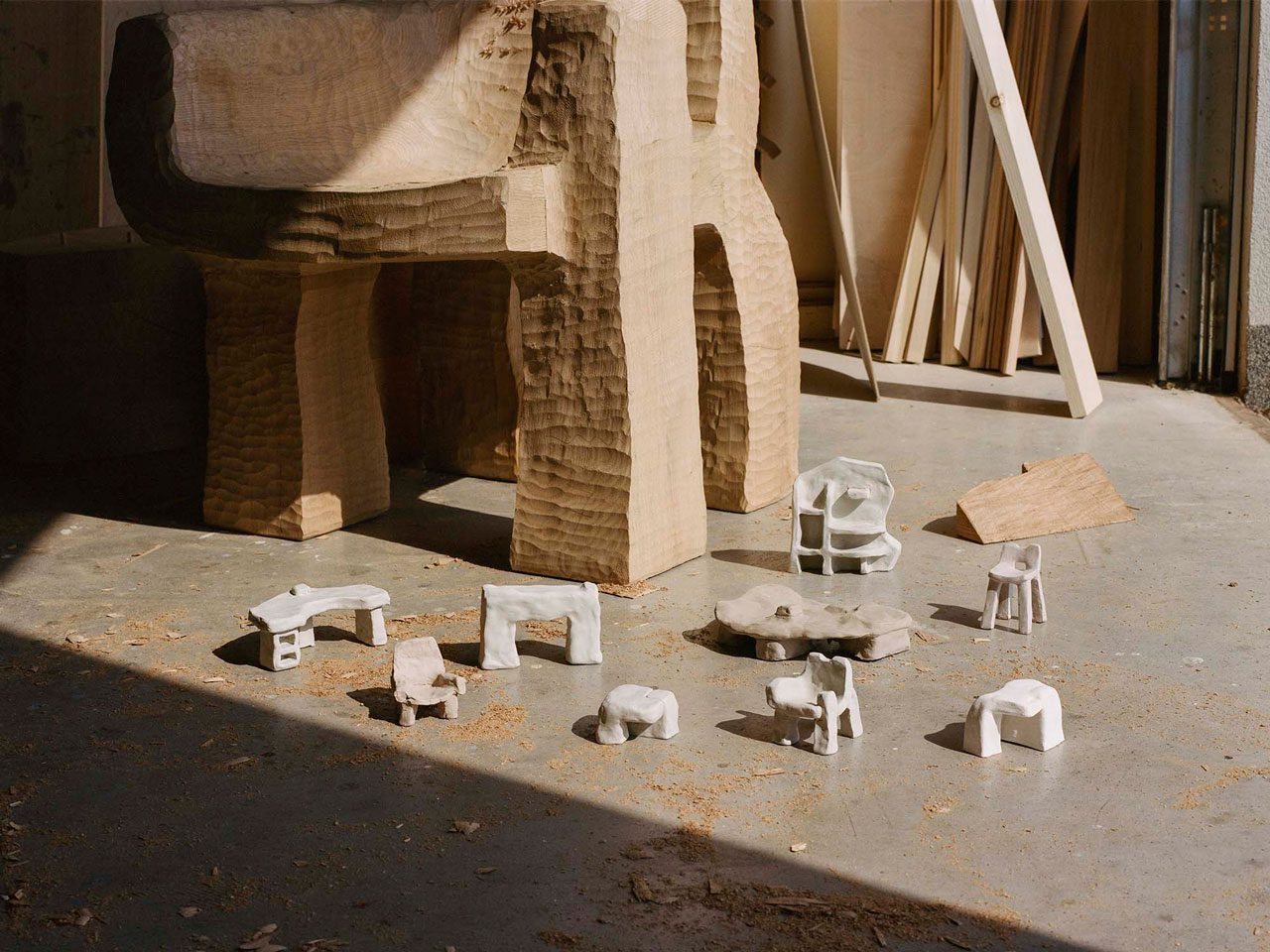 British designer Faye Toogood has emerged as one of the most prominent women in contemporary design today. “Whether you are a fashion designer, a furniture designer, or an interior designer, the materials you can get your hands on are essential,” she says. Faye Toogood’s solo exhibition “Assemblage 7: Lost and Found II” is a personal exploration of what is lost, reworked, and reclaimed. With a focus on two mediums (English oak and Purbeck marble) the exhibition is an exploration of the excellence of British craftsmanship and material landscape. Historically significant, both materials draw on the nation’s vernacular forms and traditions of making. Oak, a mainstay building material, is finished using shellacking, a time- honored fine furniture technique dating back to the 18th century. Purbeck, a rare limestone packed with shell fossils and quarried since antiquity, is sourced from a family-owned quarry on the Isle of Purbeck in southeast Dorset. It is hand-carved and chiseled, revealing the treasured stone’s stratigraphy. A continuation of Toogood’s expansive way of working,” Assemblage 7″ represents her closest approach to traditional as well as modernist sculpture. While all pieces started as clay models, working with the actual materials felt, in Toogood’s words “like an archaeological dig: The block was a landscape, and I was finding my treasure within this block.” When carving, ancient material memories emerge into the light and take contemporary forms. Each piece, “Plot” , “Cairn” , “Barrow , Hill” , “Hoard” , and “Lode” represents undiscovered places and elements that had long been hidden —“something almost prehistoric that had been lost to time,” says Toogood. Info: Friedman Benda Gallery, 515 West 26th Street, New York, NY, USA, Duration: 11/1-15/3/2025, Days & Hours: Mon-Sat 10:00-18 :00, www.friedmanbenda.com/
British designer Faye Toogood has emerged as one of the most prominent women in contemporary design today. “Whether you are a fashion designer, a furniture designer, or an interior designer, the materials you can get your hands on are essential,” she says. Faye Toogood’s solo exhibition “Assemblage 7: Lost and Found II” is a personal exploration of what is lost, reworked, and reclaimed. With a focus on two mediums (English oak and Purbeck marble) the exhibition is an exploration of the excellence of British craftsmanship and material landscape. Historically significant, both materials draw on the nation’s vernacular forms and traditions of making. Oak, a mainstay building material, is finished using shellacking, a time- honored fine furniture technique dating back to the 18th century. Purbeck, a rare limestone packed with shell fossils and quarried since antiquity, is sourced from a family-owned quarry on the Isle of Purbeck in southeast Dorset. It is hand-carved and chiseled, revealing the treasured stone’s stratigraphy. A continuation of Toogood’s expansive way of working,” Assemblage 7″ represents her closest approach to traditional as well as modernist sculpture. While all pieces started as clay models, working with the actual materials felt, in Toogood’s words “like an archaeological dig: The block was a landscape, and I was finding my treasure within this block.” When carving, ancient material memories emerge into the light and take contemporary forms. Each piece, “Plot” , “Cairn” , “Barrow , Hill” , “Hoard” , and “Lode” represents undiscovered places and elements that had long been hidden —“something almost prehistoric that had been lost to time,” says Toogood. Info: Friedman Benda Gallery, 515 West 26th Street, New York, NY, USA, Duration: 11/1-15/3/2025, Days & Hours: Mon-Sat 10:00-18 :00, www.friedmanbenda.com/
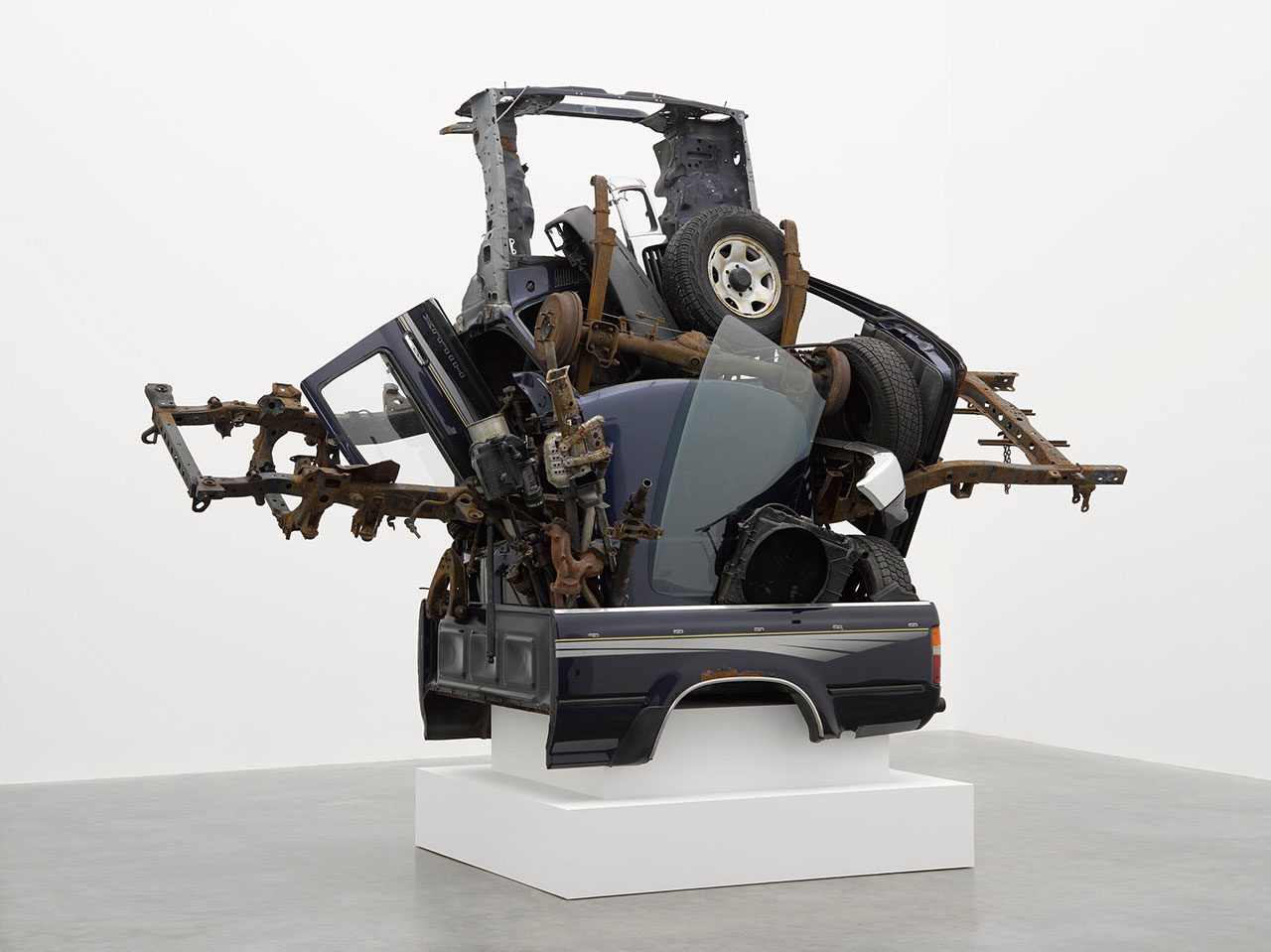 Virginia Overton presents a solo exhibition in London, her work, which includes installation, sculpture and photography, is often the result of her direct intuitive response to a specific space. From a process of research and exploration, she creates works that re-activate the viewer’s spatial and sensory experience with an elegant physicality. Infused with an ethos of economy, Overton employs everyday, elemental materials to engage with a site, its geographical location and history. Wooden planks, beams, metal, mud, sheetrock and bricks – things commonly associated with construction work or farming – are cut, bent, stacked and hammered into shape, often pushing the material to its physical limit. The objects used can be salvaged and recycled from one project to the next, found in situ or in the environs of the exhibition space. Evincing the power and sensory quality of their own textural materials, her sculptures and installations, through their new functionality, expose the energy and associations encapsulated within their parts. ‘I like for the work to act as a marker of its own history – letting accrued defects show in the pieces – that talks about the ways in which the materials have been used’, she explains. Info: White Cube Gallery, 25 – 26 Mason’s Yard, London, United Kingdom, Duration: 17/1-22/2/2025, Days & Hours: Tue-Fri 10:00-18:00, www.whitecube.com/
Virginia Overton presents a solo exhibition in London, her work, which includes installation, sculpture and photography, is often the result of her direct intuitive response to a specific space. From a process of research and exploration, she creates works that re-activate the viewer’s spatial and sensory experience with an elegant physicality. Infused with an ethos of economy, Overton employs everyday, elemental materials to engage with a site, its geographical location and history. Wooden planks, beams, metal, mud, sheetrock and bricks – things commonly associated with construction work or farming – are cut, bent, stacked and hammered into shape, often pushing the material to its physical limit. The objects used can be salvaged and recycled from one project to the next, found in situ or in the environs of the exhibition space. Evincing the power and sensory quality of their own textural materials, her sculptures and installations, through their new functionality, expose the energy and associations encapsulated within their parts. ‘I like for the work to act as a marker of its own history – letting accrued defects show in the pieces – that talks about the ways in which the materials have been used’, she explains. Info: White Cube Gallery, 25 – 26 Mason’s Yard, London, United Kingdom, Duration: 17/1-22/2/2025, Days & Hours: Tue-Fri 10:00-18:00, www.whitecube.com/
